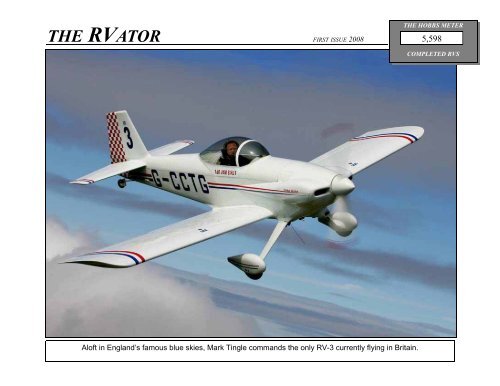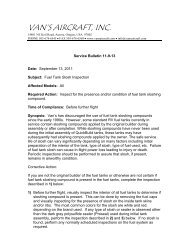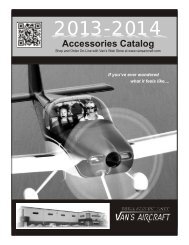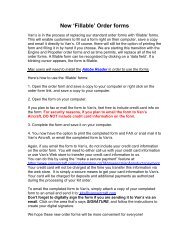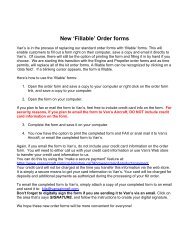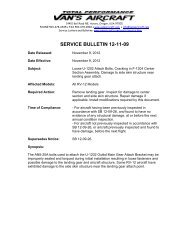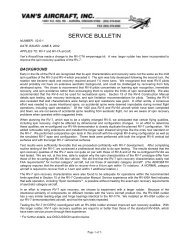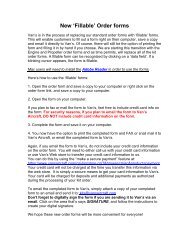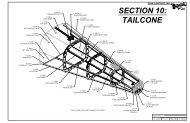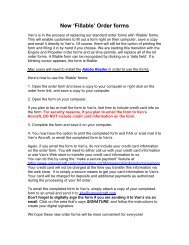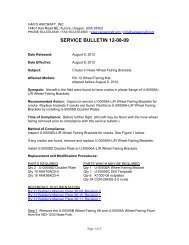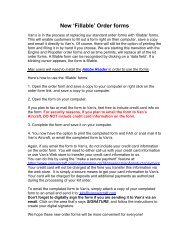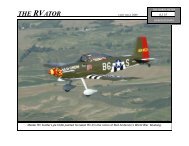2008-1 - Van's Aircraft, Inc.
2008-1 - Van's Aircraft, Inc.
2008-1 - Van's Aircraft, Inc.
- No tags were found...
You also want an ePaper? Increase the reach of your titles
YUMPU automatically turns print PDFs into web optimized ePapers that Google loves.
THE RVATOR FIRST ISSUE <strong>2008</strong>THE HOBBS METER5,598COMPLETED RVSAloft in England’s famous blue skies, Mark Tingle commands the only RV-3 currently flying in Britain.
VAN’S ADDS A WINGNo, nothing aerodynamic.We are adding a new “north wing” to ourbuilding, adding significantly to our availablefloor space. We will use the area to house ourwoodshop, where Jim Daggett and his crewbuild the crates that take RV kits all over theworld.When we moved into this building almosteight years ago, we just couldn’t get over all theextra room...now we’re adding on.MEMORY LANEWe were pleased to get a note recentlyfrom Dick Murphy.Dick, of Corvallis, MT, built thisRV-3 from the first (partial) kit Vanshipped back in 1974. He finishedthe airplane in 1976. He flew it toOshkosh that year, where he posedfor this picture. “I feel honored tohave been a small part of such agreat story,” he says.Kind of a large part, we think.JULIAN AVERYMay 12, 2003 — January 19, <strong>2008</strong>The RV world is often described as an extended family, and whenever you lose a familymember, it hurts. When that member is only four years old, it really hurts. Julian Avery,son of Ken and Mimi Avery and grandson of Bob and Judy Avery (all of Avery Tools), diedJanuary 19 after a brave fight against a brain tumor. The family requested those attendingthe memorial service wear yellow — Julian’s favorite color. Hundreds of yellow balloonswere launched from the church. At the same time, we sent our thoughts skyward fromAurora.For more about Julian and appropriate donations, see www.juliansworld.org2
A CALL TO ARMS!VANI have written about the FAA ARCmeetings over the past year or so,most recently in my articles "Pokinthe Bear" and "Look Back-LookAround-Move Forward". These articlesexplain the FAA's concerns overexcessive commercial abuses of theExperimental Amateur Built (E-AB)licensing category. The ARC committeewas created as an FAA/EAA/Industry process to address the FAAconcerns and to recommend correctiveactions. In the last report themeeting process had concluded andthe FAA was soon to publish the reportof those meetings, to be followedby their publishing new proceduresfor implementing the licensing of E-AB aircraft.On Feb. 15th, the FAA published,in the Federal Register, their report ofthe ARC meeting process. <strong>Inc</strong>ludedin this report were indications that their proceduralchanges would probably include changes to the criteriafor determining eligibility for airworthiness in the E-ABcategory. In other words, re-defining the level of prefabricationand assembly permissible for kits. Alsopublished at that time was a moratorium on new kitcompliance evaluations.Quote: "The FAA Production and Airworthiness Division(AIR-200) is suspending evaluations of all manufacturedor compiled aircraft kits intended to be fabricated andassembled by amateur builders under 14 CFR part 21,section 21.191 (g), Operating Amateur-Built <strong>Aircraft</strong>. Effectiveimmediately, all FAA personnel will immediatelycease amateur-built aircraft kit evaluations."The way this final sentence is written, it can be, andapparently has been, misinterpreted by some. It pertainsto new kit compliance evaluations, not to the kitmodels you are now building or which we are now marketing.For more on this issue, see “RV-12 Notes” atthe end of this article.Otherwise, the REPORT is generally what I had expected,from what I had remembered from the meetingsthemselves. A number of statements made emphasizedthe FAA position and sometimes minimized oromitted the industry position. This is not too unusualas they edited and published the report. I’m not goingto nit-pick those details here. I’ll just concentrate on themost important point, which is the strong indication thatthey plan to make changes to the policies determiningwhat constitutes an “Amateur Built” aircraft.THE “RULE”---- AS DEFINED BY THE CHECKLIST.What constitutes an “Experimental Amateur-Built”?We commonly know it as the “51% Rule”. The tool formaking the determination is usually the FAA form 8000-38 “FABRICATION/ASSEMBLY OPERATION CHECK-Hi, I’m from the FAA and I’m here to evaluate your kit…LIST.” This form consists of a line item list of TASKSrequired to build the various major components of theaircraft. The list has two columns in which check marksindicate whether the kit MANUFACTURER, or theBUILDER, or both, had accomplished that specific task.Since the vast majority of current E-AB are constructedfrom kits, the -38 form was created to determinewhether or not a kit, as supplied by the manufacturer,comprised less than 50% of the Fabrication and Assembly.If so, when the BUILDER performs the remaining50% plus of the Fabrication and Assembly, theaircraft qualified for E-AB licensing.RULES CHANGE?The FAA feels that by changing the –38 checklist,they can make it a more effective tool to use in theireffort to solve the problem of excessive levels of CommercialAssistance. Industry worries that such changesmay have serious impact on mainstream E-AB aircraft.FAA TO TEST NEW RULES/PROCEDURES ON EX-ISTING KITS!Though the FAA has not yet published their newprocedures for licensing E-AB aircraft, they have statedplans to review examples of existing 51% compliant kitsas one means of creating, or field testing, new compliancepolicy.Indications are that these existing kits will not be injeopardy of losing their "Major Portion Compliant"status because of this voluntary review visit. Our goalis that the FAA will agree that future kits of similar naturewill still be compliant.FAA TO REVIEW/STUDY RV-7 QUICKBUILD KIT.LETTERS OF SUPPORT SOUGHTThe RV-7 QuickBuild kit is one of the representativekits scheduled to be reviewed, some time near the end3
of March 08. Our understanding is that this is to be areview only, and should not have any effect on the futureof this kit. Obviously, it is our intent to show theFAA that this existing, widely built, successful E-AB aircraftmeets the intent of the 51% rule and that futurekits of similar composition (parts and assembly detail)should continue to be found to be major-portion compliant.Primarily we expect that we will need to explainand justify some of the shared task processes of ourexisting kits. We also feel that it would be of greatbenefit for the FAA to receive favorable comments frombuilders supporting this point of view.MORE BACKGROUND DETAILOver the years, as kits became more detailed andcomplete, the FAA developed a procedure for determiningwhether E-AB aircraft complied with the letterand intent of the regulation. The primary tool for makingthis determination is the FAA 8000-38 form, Fabricationand Assembly Checklist. This checklist is a systematicmethod of listing who, the kit manufacturer orthe builder, accomplished each of a long list of generalizedTASKS required to construct a typical sport airplane.For each line item (task) listed, there have beentwo columns in which to place check marks assertingwho, the manufacturer, the builder, or both, accomplishedthat specific task. While the original intent ofthe -38 authors is open to debate, it has become acceptedpractice for the manufacturer and the builder toshare credit for some tasks where there is significantfabrication and/or assembly input from both parties.This has worked well in most instances, but has metincreasing disfavor by the FAA in instances where oneparty, typically the builder, contributes only token effortbut yet receives 50% shared credit. As a result, thereis strong feeling within the FAA that a SINGLE CHECKsystem should be used, and that tasks should be creditedto only the party performing the major portion ofeach task. Many of the kit manufacturers and buildersdisagree because their experience has been that sharingtasks is a more reasonable method. In many instancesit has evolved as BEST PRACTICE for themanufacturer to contribute machine technology andmanufacturing equipment, and for the builder to contributehis skilled labor and hand tools to the complete fabricationprocess. This combination of shared resourceshas resulted in the most consistent airframes and thebest and safest finished aircraft. Many in industry feelthat the Single Credit check system would result in policydriven manufacturing and construction decisionswhich would not enhance safety, and would result inkits less attractive to builders. Fewer kits would be soldand fewer airplanes built — we’d all lose.SOME EXAMPLESSome members of the FAA on the ARC committeeliked to use the example of a "FABRICATE RIB" as atypical task for determining the MAJOR PORTION.Their simplistic example states that if there are 30 ribsin the aircraft's wings, then the builder must fabricate atleast 16 of the ribs in order to receive credit for thattask. The manufacturer could supply the other 14 ribs,but would receive no credit. Under their suggested SIN-GLE CHECK system, the builder would then receive fullcredit for this task. Back in the days of wood and fabrichomebuilts, this approach might have made sense.The stick and gusset ribs fabricated by the manufacturerwould be of the same technology as those fabricatedby the builder.For current day aluminum homebuilts, wing ribs fabricatedby the manufacturer are far superior to thosethat could be fabricated by the average builder becauseof the manufacturer’s tooling, manufacturing machinery,and manufacturing volume. Thus, current practiceis that the kit manufacturer, in a very time and cost effectivemanner, performs the initial fabrication of all ofthe ribs. The builder then performs the finish fabricationfunctions such as edge finishing, flange straightening,cleaning and primer painting, etc. of all of the ribs. Thisshared fabrication process also applies to most otherparts of aluminum kit aircraft. At first glance, the kitpart received by the builder may have the outward appearanceof a finished part. In fact, the time required tofinish process them to make them assembly-ready isoften greater than that expended by the manufacturerduring initial fabrication process. Shared fabricationhas been found to be the BEST PRACTICE for achievingthe highest quality and most affordable kits!For another example, we can refer to the EM-PENAGE section of form 8000-38. One line item is:FABRICATE Vertical Stabilizer Spar. Historically, wehave shared this task because the manufacturer machineshears and bends the spar components, and theBUILDER then performs finishing functions, primerpaints and rivets the pieces together to form the SPAR.We feel that this is a very reasonable concept. TheBUILDER does not have the machinery to properly prefabricatethe component parts, and the MANUFAC-TURER does not want to perform the finish and assemblytasks because of the time and labor cost required.It is the BEST PRACTICE. Do we want a check listpolicy which effectively forces 100% completion by oneparty or the other?At first glance, it may seem that the dual check systemis futile because the equal credit given to theManufacturer and the Builder has a canceling effect.For a specific single task line this may be true, but inthe final bottom line tally process, there is often a cumulativebenefit to the interest of the manufacturer andbuilder.Over the past 15 or so years, the FAA has beenevaluating aircraft kits at each manufacturer's facilitiesto determine compliance with the "51% Rule", and havemaintained and provided the public with this list of demonstratedeligible kits. However, the FAA personneland DAR inspectors performing the E-AB airworthinessinspections have rarely required the builder/applicant topresent the completed -38 form at the time of final airworthinessinspection. I would imagine that few past4
and current builders have even seen the -38 list fortheir kit aircraft. For this reason, here’s a link to the8000-38 forms which <strong>Van's</strong> supplied to the FAA duringthe compliance evaluation of the RV-7 Standard andQuickBuild kits: http://www.vansaircraft.com/public/8000-38.htm The -38 forms for other RV modelsare very similar. You should become familiar withthese forms to help you make specific comments andrecommendations to the FAA. You need to be on thesame page.SOME THINGS HAVE CHANGED----THIS IS <strong>2008</strong>The interpretation and application of the -38 formhas evolved over the thirty or so years since it was firstcreated. This is only logical because typical amateurbuilt aircraft designs have changed, as has the kit aircraftmanufacturing infrastructure. During the earlyyears, most kit manufacturers didn't even request kitevaluations by the FAA because their kits were so basicthat they unquestionably met the 51% RULE requirement.In the early 1990's the first FAST BUILDkits appeared. The developers of these kits had rationalizedthat for the purpose of EDUCATION, the builderneed not accomplish over 50% of each task. They feltthat he should be credited for shared accomplishmentof a task through performing a "Significant Amount” ofthe work, more than enough to receive the desiredEDUCATIONAL benefit. As composite kits with theirlarge pre-molded components entered the picture, theinterpretation of task credits evolved further. The importantpoint here is the fact that the FAA, at headquarterslevel, accepted these interpretations and evaluationprocedures and issued kit compliance approvals onthis basis over a period of at least 15 years. Now, in aneffort to curb what they see as egregious abuse of“Pro-Building” and "Excess Factory Builder Assistance",the FAA has stated a desire to apply a muchmore strict interpretation of the 51% rule.LETTER and/or INTENT OF 51% RULEFrom the way the application of the 51% Rule hasevolved, it is obvious that the INTENT of the rule hasperhaps been applied more than the LETTER of therule. The intent is that the amateur builder constructsthe aircraft for the purpose of education and recreation.Applying the LETTER of the rule might mean countingthe number of ribs, rivets, or rib stitches accomplishedby one party or the other. Most current Fast Build kitswould probably not qualify under a strict LETTER of therule examination. If the builder were required to performthe major portion of all fabrication tasks as well asassembly tasks, even a present day standard kit mightnot qualify as “Major Portion”. Despite this, we definitelyfeel that our kits all meet the INTENT of the rule,and that this is the more important factor.Industry's position in this review process will be toattempt to justify and retain what we feel is good aboutthe current (old)-38 checklist. Primarily we expect thatwe will need to explain and justify some of the sharedtask processes of our existing kits. Indications are thatthese existing kits will not be in jeopardy of losing their"Major Portion Compliant" status. We want to be surethat future kits of similar nature will still be found to bein compliance.SPEAKING OF SAFETYWhen preparing comments to the FAA, it is importantto address any reference to “Safety” in light of thefollowing:Safety is, or is not, an issue depending upon thecontext in which it is being used. When the FAA createdthe Experimental Amateur Built category, they exemptedamateur Built <strong>Aircraft</strong> from the requirement ofcomplying with the (safety) Standards of Type Certification.Therefore, safety was essentially relegated to asecondary status, at least within the wording of the rule.In the real world, E-AB safety is important to theFAA because of the increasing numbers of E-AB aircraft,and because safety is the ONLY reason for theFAA’s existence. This creates a paradox: safety is notparamount in the E-AB rules, but is very important inthe real world.For Instance: You’ve probably heard pilots say:“The FAA should permit professionally-built kits becausethey are SAFER.” Whether they are or not, thisstatement will not likely influence the FAA becausethose aircraft did not meet the primary reason for theexistence of the E-AB category: Education and Recreation.The stock FAA retort is : “If you want to build anairplane commercially because it will be safer, we haverules for that. It’s called a Type Certificate”.On the other hand: The FAA should more favorablyreceive comments advocating that the new policiesshould permit a reasonable amount of factory fabricationand/or assembly of kits, on the basis of the consistencyand quality provided by factory technology andequipment can enhance SAFETY. The FAA is interestedin promoting safety of E-AB aircraft, but they alsoinsist that the aircraft they license as "Amateur Built"meet the primary requirement of that category: that themajor portion be fabricated and assembled by thebuilder for education and recreation.IT’S TIME TO ACT —WRITE NOW!To help convince the FAA of the "Major Portion"legitimacy of current kit practices, we feel that publiccomment to the FAA would be very beneficial. We feelthat builder experience and opinion is credible to theFAA, perhaps even more so than that of the kit manufacturers.Thus, we are asking that you contact theFAA and share your experience, comments, and requestswith them.While it would be unfair to say the FAA's experienceis strictly "Inside the beltway", it certainly does notequal your collective “Real World” experience!Really, this is where the rubber hits the road. Youguys (and gals) are the primary players in this game.You are the builders of these airplanes and are the5
ones licensing, maintaining, and flying them. Theseare not E-AB airplanes until you take the materials andcomponents supplied in a kit, add engines, instruments,etc., etc., etc., and request an airworthiness certificatefrom the FAA. We feel that the FAA needs to hearfrom you, based on your experience, why you feel thatthe aircraft you build from these kits truly qualify asAmateur Built. If you have built one airplane or many;write. If you are still in the building process; write! Ifyou have not started building, even if you may never,write if you agree that most kits as we now know themare beneficial to general aviation.There is a lot of print on the EAA website encouragingmembers to petition the FAA to “Preserve the 51%Rule”. That’s fine, as a generality. The problem is thedefinition of the 51% rule. Does it mean counting rivets?What I think we need to petition for is“Preservation of the 51% Rule as now applied to mainstreamkit aircraft.”Rather than provide a form letter or a sample letterto send to the FAA, I’m going to make a few suggestionsof points I feel should be made to the FAA. Useyour own words. Form letters do not impress as much.Below are some thoughts and questions. Answerscan be a basis for what you need to tell the FAA.Current RV kits, and similar kits for similar mediumperformance airplanes, are not a problem and havenot been identified as such by the FAA. Any policychanges which would cause these kits to be more difficultto build would negatively impact safety, have anadverse economic impact on the kitplane industry, andimpair the growth of the GA fleet. These kits are not aproblem, so why should their manufacturers and builderssuffer negative impacts?1. Specifically; What kit have you built, or are currentlybuilding. Standard or QuickBuild. Whathas been your experience in building your RVkit? How much time did the construction take?Construction Hours, months, years.2. Particularly if your kit was/is a QuickBuild, detailthe work which you had to do to complete it.3. What did you learn; how did you grow as a resultof this building experience?4. Did you feel that you contributed the Major Portionof the construction process? Why? Asmuch detail as you wish to present about thework you did and the processes and techniquesyou learned.5. Do you feel that "Shared Tasks" are a soundand reasonable concept as opposed to tasksbeing relegated specifically to either the manufactureror the builder?6. Do you feel that the effort required of you hasprepared you to maintain and operate the aircraftsafely?7. Why do you feel that it would be unwise for theFAA to roll back the rules and require buildersto do more of the basic parts fabrication tasks?8. Do you feel that if you were required to performsome of the more complex tasks now suppliedby the manufacturer, the aircraft might be lesssafe?OK, that should be enough to get you started. Insome circumstances it may be possible and desirableto meet and help each other. Let’s get as many lettersas we can to the FAA in the next couple of weeks.SEND LETTERS AND E-MAIL TO:Frank PaskiewiczManager, Production and Airworthiness DivisionFederal Aviation Administration, AIR-<strong>2008</strong>00 Independence Ave., SWWashington, DC 20591E-Mail: frank.paskiewicz@faa.govAN EXAMPLEThe EAA has more information on the changes theFAA is proposing. They have also posted a sampleletter, which may be viewed at: http://www.eaa.org/news/<strong>2008</strong>/public_comment_letter.pdfRV-12 NOTESBut how about the still-to-be-released RV-12 kit?<strong>Van's</strong> <strong>Aircraft</strong>, <strong>Inc</strong>.'s best option at this time is to licensethe new RV-12 as a Special LSA. This will allowour customers to build an Experimental LSA from ourkit with no doubts about gaining an airworthiness certificate.There are some good things about licensing inthis category. First, in the E-LSA category, there is no51% rule. Second, there is no limit to commercial assistance.If a builder wants to hire professional help orparticipate in a Nine-Minutes-To-Taxi program, that’sok. Third, it opens the possibility of QuickBuild Kits —something that would be a difficult fit under the 51%umbrella given the highly pre-punched/pre-fabricatedRV-12 standard kit.There are some limitations, too: no deviation fromthe prototype configuration is permitted. The intentionis that each E-LSA-licensed airplane is an exact copyof the certified, tested prototype S-LSA airplane. Essentially,they are production airplanes produced bymany different “factories.” The traditional tennis-withno-net,do-whatever-you-like latitude of the E-AB(Experimental Amateur Built) category is not available.The E-LSA airplane builder is not eligible for a Repairman’sCertificate without taking a special course. If thebuilder doesn’t choose to pursue the education, the annualinspections will have to be signed off by an A&P orLSA Repairman.Builders who wish to modify our S-LSA kit in anyway will have to submit their finished aircraft to the FAAfor certification under the E-AB rules – including the51% rule. In the past this "proof" of kit completion levelwas demonstrated by <strong>Van's</strong> <strong>Aircraft</strong> but for at least theduration of the moratorium it will become solely the responsibilityof the builder.6
RV-12 PROGRESS KEN S.Well, my expressedhope of flyingby Valentine’s Day isdust in the wind.We’re working hardevery day, but there’sso much to do ifyou’re going to do itright. Several peopleseemed to take thatlast guess as somesort of promise, so I’mnot guessing anymore.So where do westand today? The engine’sinstalled, thecanopy’s been fittedand as this is writtenScott McDaniels isworking his fiberglassmagic around thebase of the windscreen.The instrumentpanel is out on thebench, undergoingtests.One of the reasons the RV-12 has taken as long as it has...since it must be in compliance with ASTM standards, wehad to develop our own test facility to assure compliance. It wasn’t easy, but here’s Van, in the yellow hard hat,inspecting our new Spectrographic Nuclear <strong>Aircraft</strong> Analyzing Facility and Uniformity Detector. When thisbaby’s on the job, all the lights in the neighborhood go dim, but when it’s done we KNOW what’s going on in thetest airplane, right down to the hadron level.The production prototype RV-12 N412RV nears completion. TheRotax 912 ULS is installed. The muffler is very effective, muting thefour busy cylinders to a steady hum.Above you can see the free-castoring nosewheel and nosegear legthat replaces the steerable nosewheel on N912VA, the POC prototype.At right, the canopy is being finished up and rests on sawhorses inthe background. The interior of the cabin is painted the familiargray. The instrument panel is not installed.The wings have been painted and no,the airplane won’t be yellow. (I’m not telling,so you’ll have to wait and see.)Because this is an RV-12, the bigpieces will go together very quickly.We are not too far from putting air underthe tires.7
ALOFT IN AFRICAHow many of us saw Out of Africa and came away thinkingour lives would never be complete until we flew an airplaneover the Rift Valley of Kenya (preferably a Tiger Moth withMeryl Streep aboard)?Van’s engineer Rian Johnson fulfilled at least part of thedream when he spent a month in Africa, starting in Kenya.There he met up with RV-7A builder Chris Hardisty. Hewrote up this report when he returned homeRemember when your parents claimed you had bettereat your cauliflower goulash because there werepoor starving kids in Africa? You felt sorry for thosekids, even though, at the moment, starvation seemed apreferable alternative. The part Mom and Dad forgot tomention was being a kid in Africa meant you got to flyto school!At least, that’s how Kenyan Chris Hardisty was introducedto aviation: “It wasn’t a daily occurrence, butthree times a year, at the beginning of each term, weflew about 2 hours to school. My parents were ColonialPolice and we traveled in a Police Air Wing CessnaC180 flown by a pilot with only a left hand! He wouldstrap the stump on the right to the stick and fly from theright hand side!”Chris’ unique “school bus” started an addiction toflying that captured both his imagination and his pocketbook.After graduation, he became a software engineerworking on all sorts of data communication systems,eventually ending up writing bits of code for satelliteoperating systems. Then, at 45, he made a completechange of direction and now flies professionally,piloting C182, C206 and C210 charters into the gameparks for numerous companies and augmenting thiswith some instructing.Naturally, a full-time pilot wanted his own airplane,and one with a bit more…alacrity, thank you... than, thegarden-variety Cessna. Unfortunately, there wasn’tmuch to pick from. The are only 327 aircraft registeredin Kenya, even including all the airliners flown by thenational carrier. What to do?At this point, Chris met RV-8 builder Chris Harrison,who was in-country to train Kenya Airways pilots on theBoeing 767. Over a brew or two, Chris2 explained thevirtues of a completely conventional all-metal home-8
Mt. Kilimanjarobuilt, powered by an engine that could be found anywherein the world. Together they explored Van’swebsite and Chris1 found what he was looking for inthe RV-7A. Roomy, fast, conventional, and you could“flip” it. The order was placed and the kit duly arrived.Since shipping the kit from the US cost well over $10Kand next-day UPS to the other side of the planet from<strong>Van's</strong> is not an option, Chris took great care with eachpart (gaining more grey hairs than usual while anticipatingcutting the canopy). His son Dean helped with asteady hand throughout the project. Chris’ daughtersPaige and Shannon pointedly mentioned that thegleaming, polished, finish of the airplane might havesomething to do with family participation inthe project.Some parts required by the Kenyan CivilAviation Authority like a fire extinguishercharged with halon is not available at the localUchumi's (Kenyan equivalent of Wal-Mart). No problem: order it off the internet.Problem: it’s illegal to ship halon by sea orair into Kenya. The only alternative left wasshipment by donkey cart from South Africavia Zimbabwe so Chris asked a fellow RVerand airline pilot Robbie Herd of South AfricanAirways to bring along an extra fire extinguisherin his Airbus A310 on his nextflight. Such is life in a fourth world country.An older SuperCub engine was acquiredand given a higher mission in life. After theusual hours in the shop, the airplane flewand behaved just as well in Central Africanskies as it did everywhere else in the world.Indeed the airplane was a shining standout.Standout enough to be the opening act inthe National Airshow.When I arrived in Kenya, Chriswas kind enough to take a day outof his busy entrepreneurial scheduleand give me a little RV time inEast Africa. The morning sky wasclear. Chris arrives in a modestcommuter car and as we headthrough perpetual rush hour trafficI understood why. The traffic –which includes every imaginablemode of transport -- soon filledthe road in every direction. Whenthe road is full, the ditch is nextand when that route becomes impassable…well,pedestrians in theadjacent parking lots beware.(Later in the trip I would boardone of two buses headed to Tanzania.The other didn't make itand two were killed in the collision.)For active pilots, a close knit societyexists and has a rich historyat the Aero Club of East Africa(www.aeroclubea.net). We stopped for lunch before ourflight. History is attached to every wall, dating back tothe first prop to turn above Kenyan soil. A beautiful brunetteswims laps in the pool. I later learned she wasone of a number of accomplished women pilots in theclub (a long tradition; Beryl Markham grew up andlearned to fly in Kenya). There is no search and rescueservice in East Africa. When someone doesn't report in,everyone drops what they're doing and joins the hunt.Even if you don’t go down, you can suffer -- a bad landing(any one not gently placed on the numbers and thecenterline) will never go unnoticed. Flak will be lobbedacross the bar that evening so everyone concentratesKenya’s only RV poses with Kay Hardisty.9
on improving their stick and rudder skills, or at leastcommitting their sins somewhere out of view. As we sitdown for lunch Chris points to the newspaper frontpage, then nods his head to the right. At the next tablesits the leading presidential candidate, Rilia Odinga.In the office I make a fair trade -- one <strong>Van's</strong> <strong>Aircraft</strong>Calendar for a cup of tea -- and meet Fred Opot, theone and only DER/DAR in the country. Along with Fredwas Ken Taylor, Chief Engineer at CMC Aviation,whose mastery of aircraft knowledge is eclipsed only byhis unparalleled skill in profanity. This is probably connectedto the skills of the low-time pilots who rent hisairplanes. When he started the RV-7A, Chris knewnothing about building airplanes. He would take his latestassembly to Ken and his team at the maintenanceshop for inspection. This resulted in a beautiful airplaneand a shop crew who now refer to 5Y-BTE as "our" aircraft.From the fit of the cowl and spinner back to thetail, the airplane is quality workmanship. This no doubtmade it easier to “sell” to the authorities. None of themhad ever seen a homebuilt airplane before becauseChris' "experimental" airplane was the first of its kind tofly in Kenya. There was a lot of regulation creation andcreative interpretation.Fed and watered, it’s time to fly. Before wheels canleave the tarmac a flight plan first must be filed (passthe offering plate) that states exactly where we willtravel. Landing fees of $10 must be paid for each landingunless doing touch and goes at your home airport,where you pay only once. If you have an Americanaboard and are landing at a game park, tack on another$40.At the airfield gate a guard nods "jambo" (hello) andchecks that the mzungu (white man) with Chris has avalid pilot’s license as permission to enter. The RV-7AThat Grin is same, anywhere in the world. Chris turns base over the Kenyan coast.is kept in a large maintenance hangar. After filling thetanks with Avgas at $1.18 a liter (less than it is atAurora! ed.) we get a clearance to taxi to the securitycheck area. A young man in a uniform (Africans respectuniforms. At some airports, if you do not wear pilot barson your shoulders, even to fly a Cessna or an RV, thereis a good chance of being detained until you can proveyou are not an impostor) walks to the wingtip and yellsin Swahili above the propeller noise, Chris yells backour flight plan and we move off towards the runway.After clearance, an RV takeoff, which is impressive at alight 1055 lb empty weight, even though most of thecountry is at roughly 5000 feet.The O-360 Lyc purrs behind the fixed pitch Sensenichprop that pulls us along towards Mt Kilimanjaro, thetallest free standing mountain in the world at 19,340’. Iam supposed to climb that in a few weeks, and as thepeak, shrouded in afternoon cumulus, is over 11,000’above our altitude, that’s a sobering thought. Eventually,we descend and make a low pass over our checkpoint,a small strip near a game lodge in Amboseli NationalPark. Turning back we follow the river, the nucleusof the wildlife population, passing over elephant,giraffe, buffalo and many, many DLC (deer-like creatures).Wow -- how many ever get this view! Our nextturning point is Lake Magadi in the Rift Valley – a gashin the Earth’s surface that extends from the Dead Seain Israel down through much of Africa. The lake is famousfor its pink hue caused by soda dissolved in thewater. The color is so strong it actually transforms thecolor of the white flamingos that live here. Even at 8000feet flocks of various large birds more than make up forthe lack of manned air traffic. Coming back over theNgong Hills we report into Wilson approach at an opulentcastle-like monastery, a check-in point. Irony presentsitself, as the building is near to Kibera, secondlargest slum in Africa, home of a millionliving in one square mile.With a reputation on the line, Chrisflares into a perfect landing, right onthe numbers and down the centerline.At the club the day’s flying adventures,especially to and from themany game parks that fuel the Kenyantourist industry, are retold withmore honesty after each beer. "Havea beer on me," one pilot who hasflown in the RV offers after learning Iwork for Van. I politely decline thebeer, but I’d sure like to meet thatbrunette.That evening we had a wonderfuldinner with Chris’s spouse Kay anddaughters Paige and Shannon; twoyoung bucking bar veterans and asupportive wife, all who enjoy trips inthe RV.From one RVer to another -- a bigthanks!10
UPCOMING SHOWSSUN ‘n FUNPrices to participate in the Sun ‘n Fun airshow haverisen steeply in the last few years, while attendanceseems to have dropped significantly. We really had toask ourselves if it was worth it, driving five or six airplanesand at least ten people all the way across thecountry in April.The answer, after considerable discussion, was yes,so we decided to participate. We will send five airplanes:our 260 hp RV-10, the RV-7A, the RV-9A andboth RV-12 prototypes (the latter via Tony Partain.) Inaddition, Mike and Georgeanna Seager will bring theirRV-7 “transition trainer.” We plan to fly some ridesfrom the Plant City airport, but exactly which airplaneswill be flying on what day is not yet determined. Ridesign-ups will not be taken in advance…those wishing ademo ride should sign up at Van’s booth as early in theshow as possible.While we are on the subject of demo rides: Ridesare one of our most powerful sales tools, and, especiallyat large shows a long way from home, we wouldlike to reserve them for prospective customers; pilotstrying to decide if one of our designs works for them.(We’ve noticed that there seems to be a belief thatbuying a kit entitles the purchaser to a ride, and somebuilders attend the large shows with the idea of“collecting” their ride. This is probably rooted in history-- twenty-five or thirty years ago, when therewere maybe three hundred RV projects worldwide,Van did offer rides to anyone currently building an RV.But now there are something like fifteen thousand projects.We just can’t offer rides to every builder anymore. The good news is that, with 5700 RVs built andflown, rides are much easier to come by.) So we’vehad to impose a few requirements for prospective riders:• Must have a pilot’s license, or be actively pursuingone (student pilot.)• Must be at least eighteen years old• Must not have ridden in an RV before (we’llmake an exception for prospective RV-10 customerswho’ve ridden in two-seat RVs.)After the success of our “on-the-field” barbeque atOshkosh, we’ve dispensed with the traditional banquetat the Lakeland Center in favor of a similar event atSunNFun. The festivities will be held in Tent 2, nearthe museum, on Friday, April 11 starting with a no-hostbar opening at 6:00 p.m.KIDVENTUREFor thelast coupleof years,Van’s hasdonatedmaterials toKidVenture,the venueat Oshkoshwhere futureairplanebuildersand pilotscancome to tryout basicaircraft constructiontechniques,determinetheir futurecareers,andjustfun…oh,haveandmake somethingcool.One of the hot itemslast year was thecustom riveted nametag. Kids loved thembecause you couldn’tbuy one, you had tomake it yourself. Accordingto KidVenturecoordinatorDan Majka: “We at Kid-Venture welcome ex- perienced riveters andA+Ps to help show the kids skills they might not everget to experience elsewhere. Anyone wishing to volunteerduring AirVenture <strong>2008</strong> can email me or walk upto KidVenture's volunteer center which is located in thehangar at EAA's Pioneer Airpark — by the museum.”11
NEW INSTRUCTOR TAKES WINGSeveral no doubt well-qualified instructors have beenoffering RV Transition Training for the past severalyears, but only two have participated in and graduatedfrom the “official” Van’s program run by Mike Seager.One of those is no longer active (as far as we can determine)so Mike and Alex deDominicis, of Ft. Worth, TX,are the only instructors in the program still working.That changed this January when CFI Brian Moentenichput himself through the Seager meat grinder and cameout a fully fledged RV Transition Training pilot. Brianflies out of Troutdale, Oregon, a few miles east of PortlandInternational airport, near the mouth of the famousColumbia Gorge. According to Brian:I spent four years building RV-6A N38155 and flewit in September of 1997. At the time, I had 150hours in my logbook – almost all of it in a C-150. Ihired Mike Seager to teach me how to fly my RVsafely and always thought about teaching othershow to fly RVs after I retired. I got my commercialrating about four months before I retired (a littleover a year ago) and my flight instructor’s certificate last September. All my training and check rides weredone in my RV except for the portions which required a complex airplane. Steve Wolf (Cottage Grove, OR)provided my spin training in a Czech Zlin aerobatic trainer. I now have over 1,500 hours in my logbook –most of them in my RV. That includes trips to the Bahamas and Alaska.The EAA used to issue letters of deviation to allow compensation when flying an experimental aircraft.Last fall, the EAA quit doing that and the local FSDOs now issue these letters (called LODAs – letters of deviationof authority). It took me several months to get one from the FAA, but it finally arrived. Then I neededto get trained by Mike Seager to learn how Van’s <strong>Aircraft</strong> wants transition training done. I accomplished thatlast week.I can provide transition training in my RV-6A for all of the “A” (nosewheel) models except for the RV-10.IN THE SHOP Ken S.Every so often we get calls from builders who wantto know the secret of repairing cracks in plexiglass.The problem is that we don’t know the secret, either.So when an article appeared in EAA’s Sport Aviationmagazine, detailing the repair of a badly damaged B-25 turret using a couple of “magic” products, I calledthe author and requested details. It turns out the authorworks for the company that makes the magicproducts (Urethane Supply Company, www.urethanesupply.com) and he kindly sent me a kit ofmaterials and instructions.So equipped, I headed out to my shop.Not willing to crack my own canopy to prove apoint, I dug around and came up with a couple of oldreplacement landing light lenses. Perfect. I drilled acouple of holes a few inches from one edge andflexed the lens to crack it into the hole. Nothing.Twisted it more aggressively. Nothing. Finally, I hit itwith a hammer two or three times. That did it. Fourteenor fifteen years ago, I drilled my canopy with aregular twist drill (didn’t know any better) and riveted itScratch-off kit from Van’s catalog and a Plastifix kit from the UrethaneSupply Company.to the steel frame with CS4-4 steel mandrel pop rivets (didn’t know any better) and yanked the skirts intosome semblance of matching the fuselage with padded vice grips and a hole finder (didn’t know any better.)So far, it’s lasted through hot and cold weather, plenty of slamming and one runaway Chevrolet. At least inmy experience, plexiglas is tougher than rumor would have it…certainly, I don’t regard that canopy as ahand grenade with a pulled pin.12
Then fix your crack with Plastifix and aluminum tape.First, crack your plexiglass. It isn’t as easy as you think.Once I had finally achieved “crack”, I set about repairingsame. The first step in the instructions was togrind the plexiglass out to “V” groove a long the crack.(Forgive the photos...taking pictures of somethingtransparent turns out to be quite difficult!) This was anacquired skill, but I finally accomplished it, using aDremel tool with a cutting burr and a fingernail-dressingsandpaper stick. Next time I’ll use the router collar thatcame with the Dremel.The kit includes a bottle of powder, a bottle of liquidand a couple of syringes with tiny applicator needles.The liquid is the activator that turns the powder into asemi-transparent, permanent filler. The directions callfor putting some aluminum tape over the back of thecrack, filling the syringe with activator and “dipping” littleballs of powder out of small cup and putting it intothe crack, filling the “V’ groove. That didn’t work at all.What did work was filling the groove with powder andusing the syringe to spread activator across the surface.In just a few seconds, the powder turned into amilky but plexiglass-like substance. After a few minutesit had hardened and bonded the crack back together.At this point, it was time for the canopy restorationpackage. I used the Scratch-off kit in our catalog.Starting with a sanding block of about 320 wet-and-dry,I brought the surface of the repair material down evenwith the outside of the canopy. There were a couple oflow spots, but a bit more powder/activator filled those.When the outer surface was smooth, I worked myway through the polishing grits to get back to a transparent,shining surface.The result was a repaired, but not invisible, crack. Itcertainly seems as strong as the original plexi, but youcan still see the cloudy ribbon where the crack was. Ican see some small problems using this fix on a finishedairplane. The surface must be horizontal, for instance,because the powder is very fine and light andwon't stay in the groove any other way.It’s not perfect (if anybody out there does have aperfect plexiglas repair technique…run, quickly, to thenearest email sending device and give me the details!)but I would be glad to use this kit to keep me flying, oras an alternative to replacing the canopy.SERVICE LETTER• February 13, <strong>2008</strong>• Subject: <strong>Inc</strong>orrect Switches in RV-10 Door Warning Light Kit• Affected Parts: Van’s Part numbers ES RS 49-496 shipped after August 2006. The switchessupplied with the above kit may be Normally Closed and not Normally Open. Check switcheswith an ohmmeter to ensure that without contact with the magnet the switch is open circuit(infinite resistance). If the resistance is closed circuit (zero resistance), the switch is incorrectand must be changed.• <strong>Inc</strong>orrect switches will be labeled with a Cherry Part number MP201702.• The correct switch label should read MP201701.• Switches without a Cherry part number should be correct, if shipped prior to August 2006.• The Door Warning Light Kit is usually shipped as part of the RV-10 Finish kit. Builders without aFinish kit, or with a Finish kit shipped prior to August 2006, are not affected.• Affected builders should contact Van’s to obtain new switches at no cost.13
TIRE FIREJohn BardIn September I was returning from New Brunswick,Canada in my RV-8A, heading for home in MountVernon, Washington. The flight eastbound to NewBrunswick had been swift. The prevailing low levelwinds were consistently high for that time of the year,and I had the heady experience of seeing groundspeeds up to 235 knots at times. Now it was paybacktime, as the return winds were similarly penalizing. Ihad been watching a line of severe weather movingacross the Plains States, and decided the best strategywas to end the day somewhere in Northern Michiganand let the system pass.I picked up a friend at a fuel stop in Ontario and bythe time we cleared Customs at Sault St. Marie, I hadalready logged 5.5 hours hand flying the RV that day.My friend agreed to fly this final leg which we hopedwould end in the vicinity of Duluth, where we would battenthe hatches for the oncoming weather. The windson the ground at all the stations we visited had beenrelatively high, and when our GPS 496 showed theweather to be between our position and Duluth as weflew west over Northern Michigan, we opted to land atthe former Sawyer Air Force Base. Sawyer was closeto our position, and the wind on the ground was reporting20 to 30 degrees off the runway, gusting as high as25 to 30 knots. My friend made an efficient approach toRunway 19, landing on the first 500 feet of the 12,300by 150 foot runway, mumbling something unintelligibleabout runway left behind.The tower gave us directions to the FBO, suggestingthat it was still 2.5 miles to taxi, which seemed to usa bit of an exaggeration at the time. About 2.5 mileslater we were about to turn off the taxiway when myfriend exclaimed the right brake had gone completelyflat, and he would gently ground-loop on the taxiway tobring us to a stop. The tower asked if we required thefire truck and we asked therefore if he saw any smoke.He replied negative, so we replied no truck required.My friend cracked the canopy and noticed a wisp ofsmoke under the right wing root. We both smelledsmoke. He called the tower and re-requested the firetruck. I bailed over the side with my 14 ounce HalonFire Extinguisher and found the right wheel fairing fullyinvolved in flame with very little smoke. I discharged thesmall bottle at the base of the flame and it extinguishedthe fire immediately, leaving only smoke and residualheat which I monitored for any re-ignition. The fire truckarrived and stood by until the fire was cold.I have concluded that not only should every RVhave a fire extinguisher on board, but that the HalonFire Extinguisher should be the agent of choice. The 14ounce size was just right for the rapid, hot burning resinof a wheel fairing. I believe those who own fiberglassairplanes should have a Halon fire extinguisher as largeas gross weight permits. (I’ve since heard a tale abouta fiberglass P-51 replica that went off a runway duringan aborted take-off, and a hot brake ignited tumbleweedswhen it stopped. The resultant fire rapidly reducedthe airplane to carbon slush.)My friend assured me he did not ride the brakes,and I believe him. We believe that the wheel fairingsupport bracket had broken and was rubbing againstthe brake disk for the 2.5 mile taxi, producing enoughheat to ignite the fiberglass resin and melt the O-ring inthe brake. That said, it is worthwhile to consider thecombined effects of high wind and lengthy taxi time onthe brakes, whether there is fire or not. Take a goodlook also at the gap between the wheel fairing bracketand the brake disk the next time the fairings are removed.The required gap isn't huge, and numerous factorsmight conspire to reduce it over time.Finally, I would like to say that should you decide tohave a mishap such as ours, you couldn't find a betterplace to have it than Sawyer. Friend Bill Landry, Directorof Maintenance at Boreal Aviation, had us on ourway the next afternoon at an amazingly low cost. I cannotheap enough praise upon Bill and his associates atBoreal. You might, however, consider a long landingwhen using Runway 19 at Sawyer.14
“FLY THE @#$%^&* AIRPLANE!”Rob “Smokey” RayAs anyone who has read an NTSB accident reportor seen any TV news footage of an aircraft crashknows, pilot error is a recurring theme.In the military, we are privy to the exploits of ourless than fortunate comrades who have “screwed thepooch, packed it in, bought the farm” or suffer other,less printable, fates. We spend hours during pilotmeetings listening to post-accident investigative hooplaon how our poor buddy had committed an act of buffooneryof royalproportions.The MP or mishappilot, as he orshe is always referredto, getshammered mercilesslyby the examiningboard almostevery time.Having been thebrunt of a USAFpost Class A mishapinvestigation(Class A denotesover 1 million dollarsdamage) myself,I can assureyou no stone is leftunturned. MostMPs get taggedwith the pilot errorlabel, and whynot? In most casesthe board is right:the cause of mostaircraft crashes isthe nut behind thestick.First, realizethat it doesn’t matterwhat type aircraftyou are in,when an emergencyraises itsugly head, yourNow you know why they call him Smokey…his airplane caughtfire! In this case the board concluded: “The failure of a magnesiumalloy restraining band surrounding the afterburner sectionof the GE F110 engine in Capt Ray’s F-16C contributed to thefailure and subsequent in-flight fire and ensuing forced flameoutlanding”.posterior is on the line, period. For us RV types wehave emergencies just like everybody else, it’s the natureof operating mechanical flying devices. Highly efficient,cool looking, fun machines, but flying devicesnonetheless. So how do we in the RV world apply thetechniques, lessons and hand to stick applications ofin-flight emergencies (IFE) to our little world?The same way the big boys handle emergencies inmulti-million dollar fighter aircraft with such aplomb.Practice, my brothers, practice. The General whoquoted that “The more you sweat in peacetime, the lessyou bleed in war” was correct, practice makes perfect.In the military and professional civilian world, simulatorsare used to “dial a disaster” for hapless pilots in a controlledenvironment. The simulator instructors can simulateemergencies with such accuracy that in cases ofreal emergencies the successful pilots claimed thatwhat they did was exactly like what they trained in thesimulator. (The exception is combat. When that firstlarge caliber round or missile flies by your canopy, allthat training goes right out the window. Been there,done that.)When the proverbial feces hits the fan an old instructorof mine once told me “wind the clock” until youcan’t stand it anymore, then think about doing something.In simulated IFEs the first step isFTFA or Fly the @#$%^ Airplane!Following these you can either pull out achecklist, have your wingman or somebodyon the ground pull one out, follow stepstherein and get home safely.The actual steps are:• Maintain <strong>Aircraft</strong> Control• Analyze the situation• Take the appropriate action• Maintain situational awarenessThe one item above left out is “don’t panic”.There is nothing short of an engine failure ontakeoff or in-flight fire that requires you to gointo “auto flail” to handle the problem. Eventhen, more people than not stall/spin trying toturn around or land too fast. Bob Hooveronce said “fly the airplane as far into thecrash as possible”. In a fighter, you do all theimportant stuff without looking and later yourwingman backs you up to make sure appropriateitems were acted uponIn RVs you can practice all kinds of IFE inyour own cockpit. You may not have a wingman,but you probably have friends who flyRVs. Use them. In the safety of your own livingroom, hangar or RV cockpit (or in mycase, Rocket…traitor!) you can go throughthe steps of any given emergency situation.Know your aircraft systems well, do a blindfoldcockpit check once in awhile and knowwhere all the switches are without looking.When you are totally familiar, have your friends be theIFE instructor and yell out simulated emergencies.While they make sound effects, wry comments andswipe beverages from your fridge, you can flail away atsolving the problem. It’s all good -- every second spentthinking about disaster helps when a real one emerges.This “game” makes everyone present a better pilot, improvessafety and gives the NTSB one less opportunityfor to conclude RV pilot error after a mishap.Practice, my brothers, practice!15
IN FOREIGN LANDSWe don’t have a lot of details, but Wood Huang, right, hasfinished and flown his RV-7… the first RV to fly in Taiwan.At left: On February 28, <strong>2008</strong> Yaron Nemet’s RV-8A 4X-OYN (82106)took off and landed safely —the first RV to fly in the country of Israel.4X-OYN is equipped with Superior XP-IO-360 Engine, Hartzell Blendedairfoil CS prop, Glass cockpit includes Advanced AF-2500 Enginemonitor, Dynon D-10A EFIS, King KMD-150 GPS and a TRUTRAKDigiflight IIVS Autopilot.“The plane flies beautifully. Thanks to Van’s for great airplane andsupport, Thanks to Dewey Conroy from Pacific Coast Avionics, RobHickman from Advanced and the Tru Track team for great support.”THE RV GRIN“Thanks for the best plane I’ve ever flown! N204C, 90878, flew with meon the 18th of February, after 2400 hours and four years of build time.What a great feeling of accomplishment!”Charles Chinberg, Dewey, AZ.16


